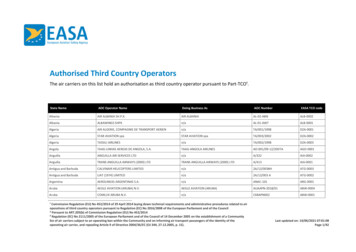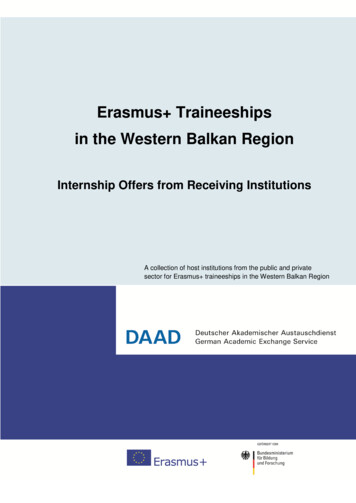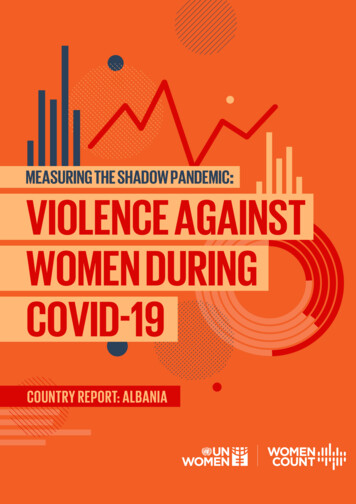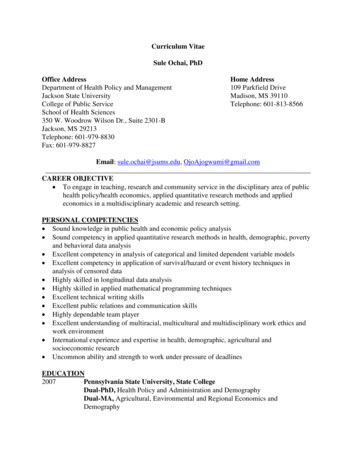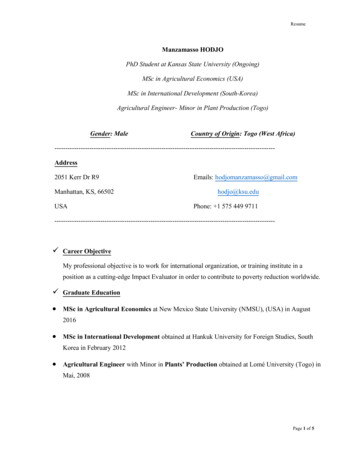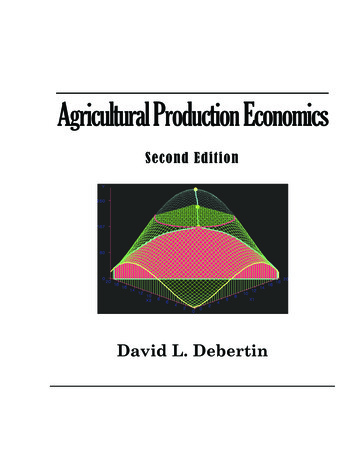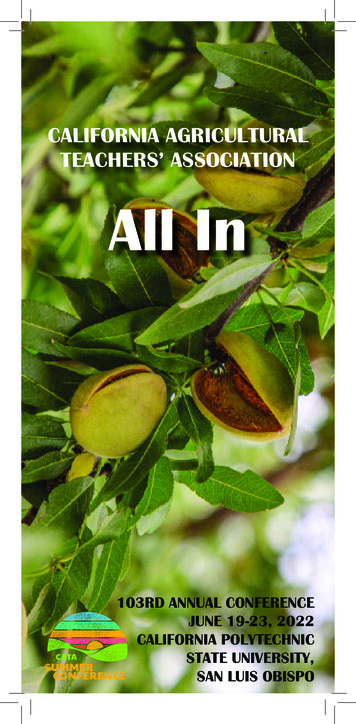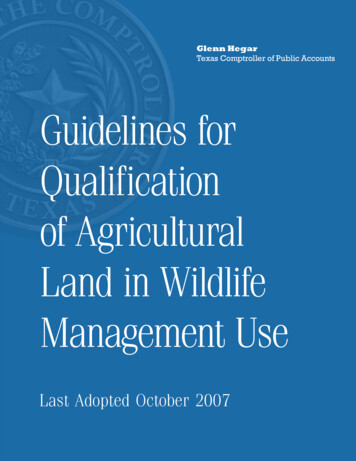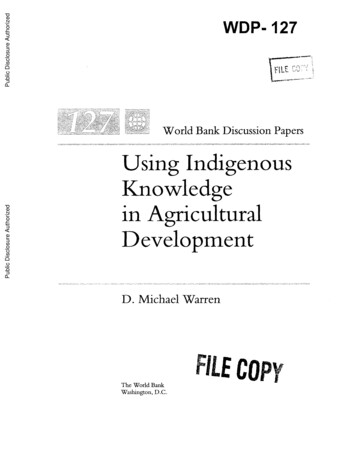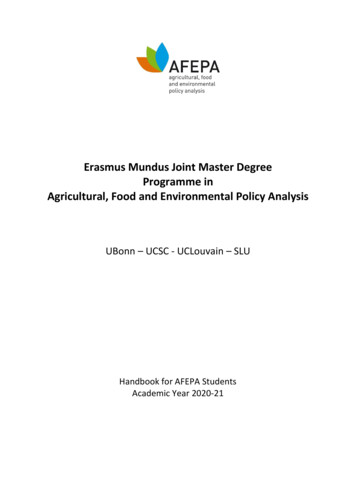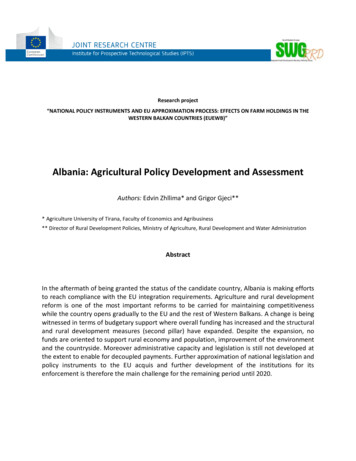
Transcription
Research project“NATIONAL POLICY INSTRUMENTS AND EU APPROXIMATION PROCESS: EFFECTS ON FARM HOLDINGS IN THEWESTERN BALKAN COUNTRIES (EUEWB)”Albania: Agricultural Policy Development and AssessmentAuthors: Edvin Zhllima* and Grigor Gjeci*** Agriculture University of Tirana, Faculty of Economics and Agribusiness** Director of Rural Development Policies, Ministry of Agriculture, Rural Development and Water AdministrationAbstractIn the aftermath of being granted the status of the candidate country, Albania is making effortsto reach compliance with the EU integration requirements. Agriculture and rural developmentreform is one of the most important reforms to be carried for maintaining competitivenesswhile the country opens gradually to the EU and the rest of Western Balkans. A change is beingwitnessed in terms of budgetary support where overall funding has increased and the structuraland rural development measures (second pillar) have expanded. Despite the expansion, nofunds are oriented to support rural economy and population, improvement of the environmentand the countryside. Moreover administrative capacity and legislation is still not developed atthe extent to enable for decoupled payments. Further approximation of national legislation andpolicy instruments to the EU acquis and further development of the institutions for itsenforcement is therefore the main challenge for the remaining period until 2020.
Albania Agricultural policy development and assessment21. Introduction and approachAlbania, as a candidate country for EU membership, is struggling to fulfil its long-term strategicobjectives and align with the requirements derived from Europe 2020 strategy. Since 2014, theyear in which the candidate status was awarded, Government of Albania is making efforts toformulate a compliant agriculture and rural development policy as well as update the legal andinstitutional base for alignment to Common Agriculture Policy (CAP).The agriculture policy is of multi-dimensional importance, from meeting the EU standardsrelated to food security and agricultural practices to preparing the agricultural sector towithstand the competitive pressures of the upcoming membership in the single market. Thatimplies that the Albania’s agricultural policy should comply with the EU’s CAP in order toachieve economically viable farming, improved food security and sustainable rural livelihood.As such, this emerging political set-up requires a new vision for policymaking as well as a newapproach for designing the budgetary support measures for the agricultural sector.The purpose of this paper is to present the key trends in agricultural budgetary transfers,discuss their implementation based on programming documents and compare them with theCAP measures in order to assess their compliance with the EU. The main objectives of the paperare to: (i) present the key trends in agricultural budgetary transfers in the country based onAgriculture Policy Measures (APM) methodology, (ii) present and discuss the national directpayments policy, (iii) summarise the new agricultural policy’s strategic and programmingdocuments, with the focus on budgetary planning and policy mechanisms, (iv) asses with thehelp of APM methodology how are the strategic and programming documents implementedwith respect to the short term agricultural policy (in terms of planned changes), and (v) providepolicy recommendation derived with focus on the programing documents.In order to carry a comparative analysis, the Agriculture Policy Measures (APM) tool was usedfor measurement and classification of agricultural budgetary support. The APM frameworkassembles a wide number of agriculture and rural development indicators which allows forcross-country analysis of budgetary support to agriculture by using uniform classificationtemplate based on the current EU concept of the policy pillars (Rednak et al. 2013). Thereforethis tool enables the analysis of three main policy pillars: market and direct producer supportmeasures, structural and rural development measures and general measures related toagriculture.The data used in this paper are obtained from the Albanian Institute of Statistics (INSTAT) andthe Ministry of Agriculture Rural Development and Water Management (MARDWA) includingthe Paying Agency. The data analysis was carried out in close collaboration with theDepartment of Agriculture and Rural Policies in MARDWA. The period covered in analysis isfrom the year 2010 to 2015. The data collection process was followed by a detailed analysis ofthe validity and harmonization between the different sources. Significant attention was paidalso on the plausibility between the stated policy measures and the de-facto implementation interms of executed budgetary transfers. However, due to a lack of written documents, a one-toone correspondence of policy measures at disaggregated level was not possible.
Albania Agricultural policy development and assessment3A content analysis was carried out based on main documents governing agricultural policyprogramming and implementation namely Strategy for Development and Integration 20142020 (GoA 2013), Government of Albania Program, Inter-sector Strategy for Agriculture andRural Development (ISARD) 2014-2020 (MARDWA 2014a), Master Action Plan for ISARD 20142020 (MARDWA 2014b) as well as updated Action Plan 2016-2018 (MARDWA 2016a). Alsoreports to Council of Ministers departments for Monitoring of Legislation and Programs(MARDWA 2016 b) are scrutinized and compared. More details on this issue will be given onsection five of this paper.The paper is structured in five sections, as follows. The second section provides a comparativereview of strategies and programming documents of agricultural policy. The third sectionprovides an overview of the agricultural policy based on a dynamic analysis of the agriculturalpolicy budgetary transfers in terms of amount and structures. The evolution of the directpayments and main constrains with regards to EU alignment will be described in section four.Finally, the fifth chapter scrutinises the main trends and divergences of the support policy withthe planned agriculture policy, followed by the main conclusions and recommendations.2. Strategies and programming documents of agricultural policyAfter being granted the status as EU candidate country in June 2014, Albania has made progressin the area of EU approximation. For instance, the crosscutting Inter-sectoral Strategy forAgriculture and Rural Development (ISARD) 2014-2020 (MARDWA 2014a) was adopted. Itsmain legal framework is the Law on Agriculture and Rural Development adopted in 2007, whichregulates the programming of policy measures related to agriculture and rural development.The ISARD 2014-2020 is reflected in the National Plan for European Integration 2016-2020(MARDWA 2016a). Also, an ISARD National Action Plan 2014-2020 and an update for 2016-2018are being prepared. The medium term action plan is detailed in a yearly action plans. MARDWAyearly action plans are reported to the Council of Ministers - Department for Monitoring ofLegislation and Programmes. Each yearly MARDWA action plan is recorded, coded, assigned toa responsible body and aligned to a determined paragraph that is previously stated in NationalPlan for European Integration 2016-2020.ISARD 2014-2020 also provides the legal basis for the national support schemes, which are setout in the annual action plans. National support schemes are determined by an annualbudgeting program and enforced by the decisions of the Council of Ministers.The first step of ISARD, which consists of starting the IPARD II Programme, is progressing. TheIPARD II Programme has been adopted by the Government of Albania (GoA) and approved bythe European Commission (EC) in July 2015 and ratified by the Albanian Parliament in March2016. At this stage, the IPARD Operating structure (Managing Authority) and the Agriculturaland Rural Development Agency (ARDA; the Paying Agency) is subject to accreditation process. Itis expected that the IPARD programme implementation will start in the first half of 2017.Other activities stated by ISARD 2014-2020 (MARDWA, 2016a) are under continuous review interms of implementation. Some of the measures are partly accomplished and left forimplementation during the period 2016-2018 and other measures are planned to be applied
Albania Agricultural policy development and assessment4after 2018 as conditions would be fulfilled as stated by the action plan in the period 2016-2018.These measures are strongly linked with the application of various support activities, and hencewill be mentioned more in detail in section five of this paper.3. Agricultural policy development in the countryDuring the period 2010-2015 (Figure 1), the budgetary support to agriculture has beenoscillating, but with an increasing trend. In 2015, the overall budgetary support amounted toEUR 35 million up from EUR 19 million in 2010.Figure 1.Break down of budgetary expenditure for agro-food sector and rural areas (Mill EUR), 2010-2015Source: APM Database - Albania 2016The budgetary support to agriculture in Albania is modest when compared to the agriculturesector’s size, needs and contribution to the national economy as well as the support given inother Western Balkan countries and the EU for this sector (Volk et al. (eds) 2014). Although thebudgetary support for the year 2015 was higher than in previous years, still its share was only1.7% of agriculture gross value added (GVA, Table 1). This figure is low considering thecontribution of the agriculture to overall GVA which is anchoring around 20% (21.7% in 2015;Agricultural statistics database - Albania 2016).Table 1: The relative level of budgetary support to agriculture in Albania, 2010-2015Budgetary support to agriculture (EUR million)GVA in agriculture (EUR million)Share of support to agriculture in GVA 01,9141.12014282,0241.42015352,0521.7Source: APM database - Albania 2016; Agricultural statistics database - Albania 2016The year 2015 was marked not only with an increase in overall budgetary support but also witha change in its composition. The structural and rural development measures (second pillar)have expanded, receiving 61% of the overall support funds (up from 39% in 2014). General
Albania Agricultural policy development and assessment5measures related to agriculture (third pillar) maintained the second position receiving 24%(down from 50% in 2014), while direct producer support accounted for 15% of the overallbudgetary expenditures (up from 11% in 2014). Direct producer support is gaining importancein Albania in recent years; however, its relative share is still much lower compared to otherWestern Balkan countries (Volk et al. (eds) 2016). Market support measures are notimplemented in Albania.The entire funding for structural and rural development measures, with the value of EUR 21.3million in 2015, is oriented to improve the competitiveness of the agro-food sector (Table 2).No funds are intended to support rural economy and population or preserving of environmentand ecosystems1.Among structural and rural development support measures the largest share of funds belongsto financing of drainage, irrigation and other water resource management infrastructure (in2010-2015, 60% on average).Table 2: Budgetary support for structural and rural development measures, 2010-2015(Mill EUR)On farm investment supportModernisation of agricultural holdingsRestructuring of permanent crops plantationsIrrigation systemsDrainage, irrigation and water management infrastructureFood processing, marketing and promotionStructural and rural development measures, .114.75.521.3Source: APM database - Albania 2016The on farm investment support has witnessed a decrease that started from 2010 (Table 2).This decreasing trend is caused mainly by the reduction in support to permanent cropplantations (especially olives). Higher importance was given to technology improvement (dropirrigation, wells and biomass heating), plantation of medicinal herbs, expansion of greenhouses,and modernisation of farms (new equipment, buildings and light constructions).The consolidation of the greenhouse and fruit sector, the achievement of self-sufficiency inmain fruits and vegetables and expansion of planted surface in perennial and yearly crops wasaccompanied with investments which link the primary production with processing and tradingsegments of the value chains. The food processing industry support started gaining importanceespecially in 2014 with the introduction of two main measures: the support that covers 50% ofthe value of investments in storage, postharvest and processing infrastructure, and supportcovering 70% of interest rates for new investments in agro-food industry sector.General support measures consist of support to agriculture research and development,advisory and extension services for agriculture, public financing of measures in the field of foodsafety and food quality (veterinary, phytosanitary measures) and other measures of a general1Measures for restoring, preserving and enhancing ecosystems dependent on agriculture and forestry are plannedto be implemented in the period 2018-2020.
Albania Agricultural policy development and assessment6character (mostly technical assistance). In 2015, budgeting for general support measuresdecreased considerably compared with 2014. This reduction was mainly a consequence ofreduced international funds relating to food safety and technical assistance (Figure 2).Figure 2: Break down of general measures related to agriculture (Mill EUR)Source: APM database - Albania 2016The budgetary funds for knowledge generation and its transfer to agricultural producers arerather stable, but in recent years represent only about 20% of total funds for this policy pillar,indicating a low awareness of the importance of knowledge for the development of agriculture.4. Agricultural direct paymentsThe direct producer support measures in the country continue to be very modest, representingabout 15 % of the total budgetary support to agriculture in 2015. However, in recent years thissupport has been increasing constantly (Table 3).Table 3: Direct producer support for the period 2010 -2015 (Mill EUR)Direct payments to producersSheep and goats (per animal)Cows’ milk (per dairy cow, per liter of milk)Honey (per hive)Other direct paymentsVariable input subsidiesDirect producer support, .4140.3170.7825.289Source: APM Database – Albania 2016The major part of direct payments goes for supporting the livestock sector, mainly in the formof headage payments for small ruminants, which on average accounted for more than 60% oftotal funds for direct payments in 2010-2015 (in 2015 76%). Direct payments are regularlyprovided also for cows’ milk production and in recent years also to beekeepers. Another
Albania Agricultural policy development and assessment7continual support was given to extra virgin olive oil (payments per litre), but was ceased in2013.Other direct payment schemes were implemented only very short time. Support to collectionand delivery of the high value fruits in extensive areas (e.g. chestnuts, pomegranates,blueberries) and lately vegetables as well as support for animal breeding (equines, rabbits andpure breed heifers) were lasting no more than 3 years and in some cases support wasintroduced only for one year (e.g. support for meat and skin delivered to slaughterhouses).The subsidies for variable inputs are very modest. Weak advocacy of agro processors and inputsuppliers as well as Albanian policymakers fear for distortions and shortcomings on targetingthe through measures for subsidising inputs, might be the main factors for this. There is a slightincrease in the recent two years of funding in this group of measures, although it is still amodest one. The enforcement of measures has been characterised by frequent changes alongthe years due to a “leakage of funds” in the past such as in the case of covering fuel costs forgreenhouse industry. This measure was used in the period before 2006 and reappeared afterlong debates in 2014 and then not used in 2015. Lack of a system for monitoring the separateuse of the fuel for agriculture (lack of separate tanks on the farms, system of colouring the fuel,customs control on fuel codes, etc.) has made impossible the longevity of this scheme. Thesame happened for the support in purchases of plastic sheets for production of vegetables. Asupport measure for pest protection of olive groves (done through fixed payment per ha) is stillexisting and increases the overall amount of input related payments.Decoupled payments do not exist, although they are core concept of CAP 2020. Basic elementssuch as Farm Register and LPIS system required as a fundamental step for the establishment ofIACS (Integrated Administration and Control System) are not ready yet. Therefore decoupledpayments will be missing in the near future (optimistic scenario to be implemented in 2020).The recent two years witnessed an increase in direct payments based on output, a measureinitiated to intensify and formalise vertical relations in the value chains. In the past directpayment based on output was used to consolidate the supply for extra virgin olive oil whichwas exempted in 2013. In 2013-2014 output related payments were being used for supportingthe collection and delivery of forestry fruits, while lately a price premium was granted for themilk delivered to dairy industry as well as for fruits and vegetables destined to collection andprocessing points.Major agriculture subsectors are characterized by high informality due to weak registration andlow fiscal control during the recent two decades. Moreover, vertical coordination is very weakdue to low contracting activity and weak cooperation (Imami et al. 2016; Gerdoci et al. 2016).5. Assessment of implementation of agricultural policy documentsThe budgetary support to agriculture and rural development in Albania has been explicitlydescribed in the ISARD 2014-2020. The current policy agenda covering the sector as promisedin the government program 2014-2020 is expected to be improved. The government budget foragriculture and rural development (which covers a part of the structural and rural developmentmeasures and the entire direct producer support policy pillar) is expected to increase 5-folds in
Albania Agricultural policy development and assessment8the period 2014-2020 (GoA 2013). ISARD has determined the overall amount of funds given tosupport schemes to agriculture and rural development up to year 2020. An expanded role ofIPARD Programme II is planned which provides a financial benefit from the EU funds of EUR 71million till 2020, while the national budget funding will increase from EUR 20 million in 2014 toEUR 23 million in 2020.In the implementation there are no strong disparities between ISARD planned and realisedexpenditures in terms of support to agriculture and rural development. The difference averagesat not more than 5% during the recent three years. In case there is less demand for a part ofthe schemes in the first six months of the year, than the funds are allocated to remainingschemes during the second half of the year.Concerns exist on the gap between the policy formulation and policy implementation especiallywith regards to national support schemes. Assuring coherence and coordination between ISARD2014-2020, IPARD II and yearly action plan with the schemes of national support to agricultureand rural development should be a priority for Albanian policymaking and executiveinstitutions. The number of support schemes is still deemed too high (10 measures with 17 submeasures) despite they are reduced in number. Number of measures is changing frequently,with no solid links to policy vision. Schemes are not always based on in-depth ex-anteevaluation which has led to the one-time/year appearance of some schemes (such as meat orskin delivery to the slaughterhouses). Moreover, some schemes survive for some years andthen vanish and are not repeated during the next budgetary program. It seems that also ex-postevaluation in terms of efficiency and impact are rare (so far only one study available, see Skreliet al. 2015). Frequent changes and short term orientation do not provide reliable incentives andorientation to the supported sectors. Thus, agriculture operators may suffer from unstableexpectations and inability to read the policy signals of the government. An example of absentsignalling is the price shock happening in the recent years due to over production in themedicinal and aromatic plants as well as greenhouse subsectors.Moreover, there are few schemes deemed to be compatible with CAP. Despite thecommitment of MARDWA expressed through the master action plan where one of theobjectives is to achieve compatibility between CAP and national scheme of support, there existvarious legal weaknesses that hampered the introduction of the CAP-like schemes on time. Inorder to schematize the analysis, a framework of measures is tabulated below, where in leftside of the table the major measures of agriculture and rural development support gaps areranked and in the right side the institutional and legislative reasons and time targets areprovided (Table 4). The targets for achieving the institutional and legislative changes to enablethe implementation of the measures are determined based on the activities described in theMaster Action Plan 2014-2020 (MARDWA 2014b). The status of achievement is described basedon the MARDWA Action plan 2016-2018 (MARDWA, 2016a).
Albania Agricultural policy development and assessment9Table 4: Support measures and relation to Master Action Plan activities by status ofachievementSupport measureInvestments in physical assets ofagricultural holdings, processing andmarketing of agricultural and fisheryproducts and farm diversification andbusiness developmentSchemes complementing IPARD IImeasures for small farmers producingfor the marketAgro-environment and organic farmingschemesAction plan activitiesNational scheme and IPARD IITime Status of achievement2016 To be implemented under 1stpackage of the IPARD measures,2017Carried out with donor’s support (GIZ- 2014 AchievedDANIDA; EUR 13.1 million of which EUR6.5 for investment grants).Organic farming and quality policy to be 2016 Not achieved yet, although somedesigned.preparations are done by FAOprojectsQuality policy support scheme forQuality policy legislation and2016 Not achieved yetagricultural products and foodstuffenforcement and implementingstructures for the alignment of thelegislation with Acquis and itsenforcementSupporting the cooperation of farmersEstablishment of producer groups and 2016 Not achieved yet and not includedand associationsassociations of agriculture cooperationin IPARD II programme as previouslyplannedEstablishment and protection of forests Restoring, preserving and enhancing2017 Not achieved yet and not includedecosystems dependent on agriculturein IPARD II programme as previouslyand forestry.plannedPreparation and implementation of local2017 Not achieved yetrural development strategies - Leaderapproach.Public investments in rural areasMARDWA investments carried in water 2017 Still ongoing since Regionaldevelopment and infrastructuresand drainage.Development Fund allocatescompeting grants for municipalitiesImprove training and strengthenBeing carried through capacity building 2017 Territorial development strategycapacities of advisory servicesprojects (donor support)and institutional changes are still tobe consideredReview/amend Law for Agriculture and Registration of farmers in the farm2016 Not achieved yet, which isRural development to provide forregister and other relevant registershampering area based supportcompulsory registration of farmers to be (animal register, LPIS, etc.)measureseligible for supportDevelop measures for access to creditSupport for the establishment of the2016 Achieved (to be activated withinRural Credit Guarantee Fund under the2016)IPA 2012 Project.Actions to support transfer of land and Legislation and pilot project prepared2016 Not achieved yetland consolidationby FAOSource: Own elaborations based on Master Action Plan 2014-2020 (MARDWA 2014b)Summarising Table 4, it is clear that the policy has been successful to prepare theimplementation of IPARD II which will enable investments in physical assets of agriculturalholdings, processing and marketing of agricultural and fishery products and farm diversificationand business development. These measures accompanied by technical assistance are designedand ready to be implemented after accreditation of the implementing structure. Howeverexcept this part of first package other activities planned are still not solved. For instance, issuessuch as strengthening of collective actions among farmers and other stakeholders, achievingland consolidation, supporting quality schemes for agriculture products, enhancing agroenvironment-climate measures and supporting organic farming are not yet accomplished.
Albania Agricultural policy development and assessment10Preparation of the legal bases (e.g. law on organic farming, common market organisations’ legalbase, law on cooperatives, land consolidation strategy and law, etc.) is taking time andMARDWA is making additional efforts to achieve it by coordinating the on-going capacitybuilding projects and in-house staff actions.A second group of measures is related to support of advisory services, preparation andimplementation of local rural development strategies under Leader approach which isundergoing subsequent changes due to the new territorial reform. Territorial restructuring isaccompanied with a vast number of changes halting the reforms on veterinary service, advisoryservices, water and irrigation management as well as land and forestry management.6. Conclusions and policy recommendationsIn the aftermath of being granted the status of the candidate country, Albania is urging for aquick orientation to comply with the EU integration requirements. Agriculture and ruraldevelopment reform is one of the most important reforms to be carried for maintainingcompetitiveness while the country opens gradually to the EU and the rest of Western Balkans.In order to align with CAP 2020 requirements the country has designed a compatible Intersectoral Strategy on Agriculture and Rural Development (ISARD 2014-2020), which is interlinkedwith the country integration strategy 2014-2020 and is guided by master action plan andmonitored by an inter-ministerial entity for its implementation and other budgetary concerns.However, despite the agriculture policy properly addresses the agriculture and ruraldevelopment challenges its implementation is still lagging behind the schedule.Overall funding for agriculture and rural development has increased but is still far from whatgovernment has targeted for 2020. Government have reduced the targets due to the recentrecession. Political targets in various documents do not match (Government Program 20132017 and ISARD 2014-2020). MARDWA is expecting to reduce the national support toagriculture and rural development and give more space to IPARD funds which will be focusedon competitiveness and also diversification. A clearer policy signalling should be provided byMARDWA and stronger links between ISARD 2014-2020 and MARDWA budget should beestablished for achieving the targets as stated in the Master Action Plan 2016-2018.A change in structure is being witnessed in terms of funding; the structural and ruraldevelopment measures (second pillar) have expanded, gaining 60% of the overall supportfunds. This policy does properly met with the structural needs of the agriculture sector. Itsupports the restructuring and increase of competitiveness of the farms, reduces theirstructural vulnerability and promotes the vertical and horizontal farm integration by supportingthe investments in postharvest and processing.Despite the expansion of this pillar, again no funds are oriented to the support of ruraleconomy and population and forestry. The structural support provided to rural development inAlbania is focused on the improvement of the competitiveness of agricultural sector. Directsupport measures are also increasing with the majority of funding going to livestock sector.Other measures such as support of cooperation, land consolidation, strengthen of advisoryservices and schemes of quality support are also not developed. IPARD II, although aims to bring
Albania Agricultural policy development and assessment11further assistance to farmers, is partially covering the various measures that ISARD 2014-2020has planned. Absorption of existing funds is hampered by the lack of non-financial supportschemes and other nonstandard financial products (such as guarantee schemes). Thecooperation with other donor projects such as EBRD and World Bank is expected to developthese instruments and increase access to finance for agriculture operators.The introduction of decoupled payments is still not possible due to legal and institutionalbottlenecks. The administrative capacity and instruments for governing per animal and per areapayments (IACS, LIPS, registers, etc.) are still undeveloped, impeding the introduction of CAPlike schemes in the future. Moreover, gaps remains in the agriculture information system forfarmers, such as Market Information Systems, as well as other monitoring tools such as FarmAccountancy Data Network, which are em
The ISARD 2014-2020 is reflected in the National Plan for European Integration 2016-2020 (MARDWA 2016a). Also, an ISARD National Action Plan 2014-2020 and an update for 2016-2018 are being prepared. The medium term action plan is detailed in a yearly action plans. MARDWA yearly action plans are reported to the Council of Ministers - Department .
